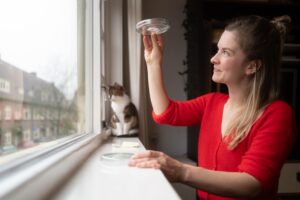Scientists from University Medical Center Utrecht (UMC Utrecht) launched an exploratory observational study to evaluate levels of micro- and nanoplastics (MNPs) circulating in the body as well as factors influencing the exposure, e.g., MNP levels in household dust. The research is being conducted as part of the AURORA project and focuses on women of reproductive age, as pregnancy represents a particularly vulnerable period potentially also being influenced by MNP exposures.
The study is being performed among 100 adult women between the ages of 18 and 45, and it includes both retrospective and prospective exposure assessments for different MNP exposure routes, including the use of plastic food packaging. Participants receive a questionnaire to evaluate factors that potentially contribute to their plastic exposure such as the usage of household items made of plastic. In addition, all participants are given a petri dish to set up at home for a 30-day period to collect passive dust samples. Each participant participates in the study for four months. Both at the beginning and the end of this period, blood and urine samples are taken from each participant for analysis.


Kaitlin Prins a research assistant at UMC Utrecht visits a participant’s home in Utrecht to collect a blood sample and place a dust collection dish at the start of the study. Photographs by Bas Niemans (Universiteit Utrecht).
Amanda Durkin, PhD candidate at UMC Utrecht, is leading the study’s day-to-day activities. “This has been an exciting albeit challenging study to plan for and execute. Plastics are ubiquitous in our daily lives, and ensuring proper sampling and analysis to avoid cross-contamination has required additional preparations and adjustments,” she explains. “If we are successful, results from this study will contribute to understanding the contribution of indoor sources and food packaging to MNP exposures and help the AURORA project test our novel measurement strategies in a real-world setting.”
After completing both rounds of blood and urine sampling for 60 of the participants, the scientists are currently working on the final round of sampling for the remaining 40. Next steps within the study include completing the final study visits in February and then our laboratory partners will take over with analyzing the samples.
Overall, the scientists expect the research to provide novel and valuable information on sources of MNP exposure, including indoor household sources such as food packaging and food preparation methods.